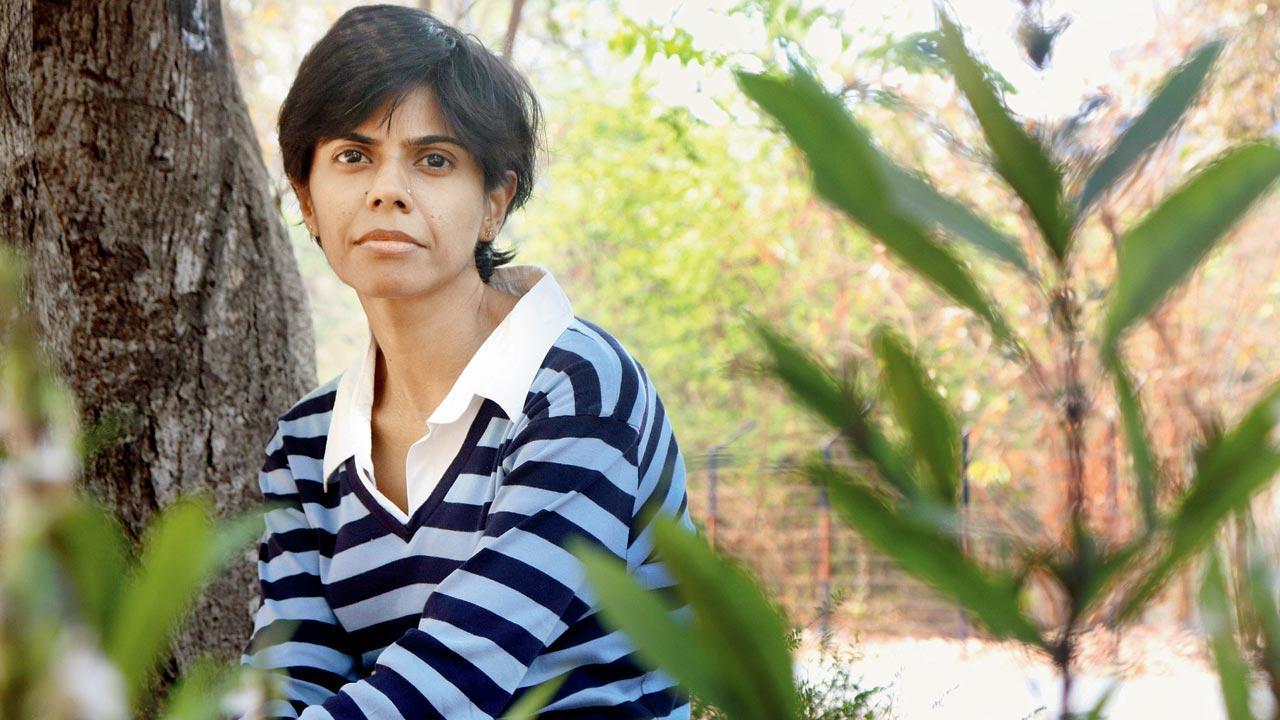A new study says 40 per cent of all Indian women are angry, as opposed to just 27 per cent, a decade ago. What’s making tempers rise?

Borivli resident Vrushali Lad admits to have always been a bit of a short-fuse. She was thin-shamed as a child, and then chided for speaking back to her elders. Being blamed for divorcing a “nice guy” didn’t help her case. Pic/Anurag Ahire
Are you angrier than before? Do you identify as a woman?” said our call on social media. “Yes!”, “Do I ever!”, “I was just talking about this to my friend this morning” came the responses quick and fast; and have not stopped two days since the post.
ADVERTISEMENT
Anger has been on a slow simmer at core of most ladies, Indian or not, and lately, it’s boiled to a rage. A poll by Gallup, a global analytics and advice firm, which looked at the issue of women’s anger, their worry, stress and sadness, found that women consistently feel these emotions more than men, particularly in India. According to the study, 40 per cent Indian women are angry compared to 27 per cent of men.
 Public relations professional Fatema Khokhar has turned to painting, pet therapy, and reading to cope with her anger. “When you involve your mind in an activity you love,” she says, “it stops overthinking and obsessing over negative incidents.” Pic/Satej Shinde
Public relations professional Fatema Khokhar has turned to painting, pet therapy, and reading to cope with her anger. “When you involve your mind in an activity you love,” she says, “it stops overthinking and obsessing over negative incidents.” Pic/Satej Shinde
But what are women angry about? Everything, it turns out: Urban living, the wide canopy of patriarchy that includes double duty of home and office, pay and respect parity at work, living in dysfunction. But most uniquely, and significantly, it is this: The forbiddance to display anger, the lack of vocabulary to express it healthily, its non-recognition and trivialisation.
What an outrage.
“I woke up angry… under a blanket of anger,” Nandhitha Hariharan tells us over the phone from Bengaluru. “Ostensibly, I have ‘nothing’ to get angry about. My partner and I distribute domestic labour, but I find myself bearing the mental load for the house and feeling guilty, if I don’t strike off everything on my to-do list.”
There is a comic strip by French cartoonist Emma that illustrates what this writer feels: Women are viewed as managers of domestic labour, carrying all the mental load, while most (yes, yes ‘not all men’) heterosexual men are implementers.
 Alita D’souza and Meenakshi Bhanj Deo
Alita D’souza and Meenakshi Bhanj Deo
Unequal division is not the reason behind Vrushali Lad’s anger, but it was a contributor to her divorce. “It was an unhappy marriage,” says the now 43-year-old Borivli resident, “We were completely incompatible, and I freelanced most years of the relationship, so the management of the home fell on me. When you have not seen each other for days, and issues are not cleared, they snowball.”
Care of children is also seen primarily as the woman’s job, points out mental health professional Meenakshi Bhanj Deo. Case in point is a couple who works in the same organisation, with more or less the same responsibilities and job description. Yet, if the child falls ill, the man’s mother is more likely to call his wife than her son to handle it. “It’s just not in our mental make-up.”
 Nandhitha
Nandhitha
Matters are made worse by the fork-tongue of patriarchy: That women are not supposed to get angry. That there is nothing to get angry about.
Then there’s the constant grooming: “Women must maintain the peace at home”. “They are taught anger is not pleasing. And when the volcano bursts, it’s easily trivialised or labelled as ‘Momzilla’, ‘Bridezilla’, ‘Hormonal’,” says Bhanj Deo, who is also an organisation development consultant. “Women are not taught to be assertive, and when they are, popular culture dismisses it.”
When anger is not recognised as a valid emotion, no tools are granted or developed to modulate and express it healthily. Feeling angry is not a concern for Fatema Khokhar. “Anger is an emotion, like sadness or happiness,” says the public relations professional, “it’s not good or bad; it’s the expression that’s
the concern.”
It took a bit of a journey for the Yari Road-resident to own her emotions. “Fifteen years ago, I would have told myself ‘You shouldn’t get angry’… I did this a lot with my friends and family in my 20s, keeping calm in turbulent situations, being accommodative,” says the 33-year-old. And then she realised that she is allowed to feel emotion and express them. She wanted to make her anger constructive, and not harmful. “My pent-up emotions and tears were climbing up gradually, and I sought the help of a therapist.”
With Lad too, the building up of anger would result in an outburst, which would seem disproportionate to the irritant. “When I have said something nine times,” she says, “and you’ve still not understood it; the 10th time is going to be a flare up.” Since Lad’s marriage wasn’t adulterous or abusive, people had much to say about the divorce. “They would say, ‘But why are you leaving such a nice guy? He doesn’t hit you or cheat on you’,” she recalls, still enraged. “No one asked him, and I did check this with him, ‘Why couldn’t you make it work with such a nice girl?’ They also assumed that since I had initiated the separation, I didn’t feel grief and didn’t need to be checked up on.”
Lad has always had a bit of a short-fuse. She was thin-shamed as a child, and then chided for speaking back to her elders or getting angry about “something so trivial”. Lately, she’s lost friends, colleagues and family members after she told them to, “Mind your own business” when they asked intrusive questions. “I have realised that keeping it inside takes a toll on me. I have felt resentful when I have not defended myself.”
Social media has both educated women about the daily injustices, but also lay naked the crudeness and hate of society in general. “You have women talking about how hard motherhood is,” says Bhanj Deo, “Or having to work harder than the man in the cubicle next to you, the pressures of care-giving—all of these are being normalised.”
Nandhitha writes movie reviews from a feminist perspective, online. And sometimes she becomes the target of collective hate or derision. “Because the identity can be masked online, the quality of the anger is raw,” she says. A metropolis like Mumbai has environmental stressors that always keep you on edge. For Alita D’souza, this was starker on her return from Dubai after working there a few years. “I came back because I was homesick,” she says, “But I can’t take the train, the rudeness, the loud noises, the pollution and the traffic. I feel like I am always angry. I have a cough that has not gone in two weeks, despite medication.” Even though she has to commute from her home in Malad to her office in Bandra only once a week, the PR professional has to go to different parts of the city for client meets, which exhausts her. “I recently joined a gym just to work on my temper.”
She’s also frustrated that she sometimes does not have the language to express her frustration, “despite being a communications professional”.
How can you develop a vocabulary for an emotion you are not supposed to feel?
Then there are the invisible violations only a woman can see. Nandhitha was at a train station in Goa, standing on the platform with her dog. A drunk man tottered close to her, asking seemingly innocent questions about her dog and the arriving train. “I raged at him disproportionately,” she says. “And I am not a person who likes to draw attention to herself. The whole station was looking at me, and my partner also wondered what happened.”
The man had invaded her personal space, and her reaction came with the force of all the times men violate women in public spaces, and women are too scared to respond.
Being the casualty of mental illness and the silence that surrounds it drives this 28-year-old to rage. “My mother has severe depression, anxiety, OCD and temper issues, and she refuses to acknowledge or take medication for it,” says the canine behaviourist and animal rescuer. “And it spills over to our life to such an extent that we are restricted and controlled by it. I cannot call anyone home because I don’t want to explain my situation, and instead, I cut ties.”
She attempted to die by suicide in 2012 out of frustration that she could not escape her house. She had another massive breakdown two months ago, which bordered on self-harm—“I got overwhelmed to the point of being violent to myself,” says the Andheri resident. “I slammed my hand on the table to stop whatever was disturbing me. My mother’s activities reached a point where I could no longer cope with the dysfunctionality of the household. I was trying to make her realise that we, as a family, are going through many things due to her. I had to reveal to her that I am seeking help for this.”
The pressure of living in dysfunctionality is also that one cannot reveal it. “My father does not know we have frequent outbursts because we cover it up and he’s at work usually; we don’t mention these to him.”
While the young woman still has an episode at least once a day in her house, she has learnt to control her temper outside. “It has cost me a job when I blew up at a senior,” she says, “I’ve had to repeat a year in college because I lost my temper at my internship in-charge. I feel this anger has built up since childhood, but I never let it out until I started working, and became more vocal and expressive.”
With a background in psychology, she was quick in seeking help to cope with an environment she could not escape. A good amount of work has been put into being aware when rage is rising, acknowledging it and diverting it into a productive activity.
Journalling has also helped her , as it has Khokhar, who also turned to painting, pet therapy, and reading. “When you involve your mind in an activity you love,” she says, “it stops overthinking and obsessing over negative incidents.”
Bhanj Deo says that mood-mapping, having a safe space to regulate your feelings, being aware of triggers and bodily reactions are all tools one can develop, “but the core solution is knowing who you are and what you want”. “Women are groomed into marriage, children, careers and home-making. And if that’s what they want, they are ready for the challenges that come with it. But if they don’t know who they are, and this pre-decided life does not fit them, they move through life with low simmering rage on a slow boil”.
 Subscribe today by clicking the link and stay updated with the latest news!" Click here!
Subscribe today by clicking the link and stay updated with the latest news!" Click here!







